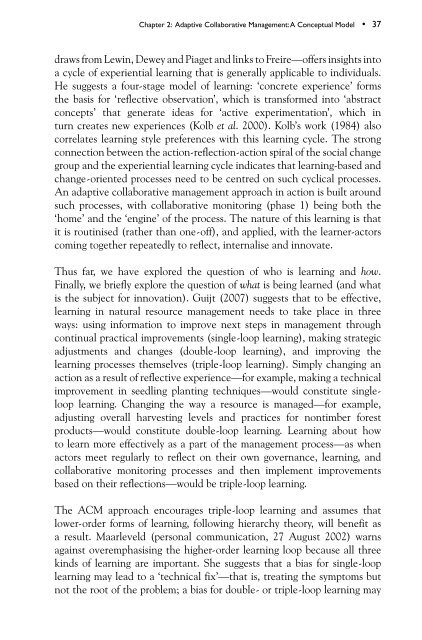Adaptive collaborative management of community forests in Asia ...
Adaptive collaborative management of community forests in Asia ...
Adaptive collaborative management of community forests in Asia ...
Create successful ePaper yourself
Turn your PDF publications into a flip-book with our unique Google optimized e-Paper software.
Chapter 2: <strong>Adaptive</strong> Collaborative Management: A Conceptual Model • 37<br />
draws from Lew<strong>in</strong>, Dewey and Piaget and l<strong>in</strong>ks to Freire—<strong>of</strong>fers <strong>in</strong>sights <strong>in</strong>to<br />
a cycle <strong>of</strong> experiential learn<strong>in</strong>g that is generally applicable to <strong>in</strong>dividuals.<br />
He suggests a four-stage model <strong>of</strong> learn<strong>in</strong>g: ‘concrete experience’ forms<br />
the basis for ‘reflective observation’, which is transformed <strong>in</strong>to ‘abstract<br />
concepts’ that generate ideas for ‘active experimentation’, which <strong>in</strong><br />
turn creates new experiences (Kolb et al. 2000). Kolb’s work (1984) also<br />
correlates learn<strong>in</strong>g style preferences with this learn<strong>in</strong>g cycle. The strong<br />
connection between the action-reflection-action spiral <strong>of</strong> the social change<br />
group and the experiential learn<strong>in</strong>g cycle <strong>in</strong>dicates that learn<strong>in</strong>g-based and<br />
change-oriented processes need to be centred on such cyclical processes.<br />
An adaptive <strong>collaborative</strong> <strong>management</strong> approach <strong>in</strong> action is built around<br />
such processes, with <strong>collaborative</strong> monitor<strong>in</strong>g (phase 1) be<strong>in</strong>g both the<br />
‘home’ and the ‘eng<strong>in</strong>e’ <strong>of</strong> the process. The nature <strong>of</strong> this learn<strong>in</strong>g is that<br />
it is rout<strong>in</strong>ised (rather than one-<strong>of</strong>f), and applied, with the learner-actors<br />
com<strong>in</strong>g together repeatedly to reflect, <strong>in</strong>ternalise and <strong>in</strong>novate.<br />
Thus far, we have explored the question <strong>of</strong> who is learn<strong>in</strong>g and how.<br />
F<strong>in</strong>ally, we briefly explore the question <strong>of</strong> what is be<strong>in</strong>g learned (and what<br />
is the subject for <strong>in</strong>novation). Guijt (2007) suggests that to be effective,<br />
learn<strong>in</strong>g <strong>in</strong> natural resource <strong>management</strong> needs to take place <strong>in</strong> three<br />
ways: us<strong>in</strong>g <strong>in</strong>formation to improve next steps <strong>in</strong> <strong>management</strong> through<br />
cont<strong>in</strong>ual practical improvements (s<strong>in</strong>gle-loop learn<strong>in</strong>g), mak<strong>in</strong>g strategic<br />
adjustments and changes (double-loop learn<strong>in</strong>g), and improv<strong>in</strong>g the<br />
learn<strong>in</strong>g processes themselves (triple-loop learn<strong>in</strong>g). Simply chang<strong>in</strong>g an<br />
action as a result <strong>of</strong> reflective experience—for example, mak<strong>in</strong>g a technical<br />
improvement <strong>in</strong> seedl<strong>in</strong>g plant<strong>in</strong>g techniques—would constitute s<strong>in</strong>gleloop<br />
learn<strong>in</strong>g. Chang<strong>in</strong>g the way a resource is managed—for example,<br />
adjust<strong>in</strong>g overall harvest<strong>in</strong>g levels and practices for nontimber forest<br />
products—would constitute double-loop learn<strong>in</strong>g. Learn<strong>in</strong>g about how<br />
to learn more effectively as a part <strong>of</strong> the <strong>management</strong> process—as when<br />
actors meet regularly to reflect on their own governance, learn<strong>in</strong>g, and<br />
<strong>collaborative</strong> monitor<strong>in</strong>g processes and then implement improvements<br />
based on their reflections—would be triple-loop learn<strong>in</strong>g.<br />
The ACM approach encourages triple-loop learn<strong>in</strong>g and assumes that<br />
lower-order forms <strong>of</strong> learn<strong>in</strong>g, follow<strong>in</strong>g hierarchy theory, will benefit as<br />
a result. Maarleveld (personal communication, 27 August 2002) warns<br />
aga<strong>in</strong>st overemphasis<strong>in</strong>g the higher-order learn<strong>in</strong>g loop because all three<br />
k<strong>in</strong>ds <strong>of</strong> learn<strong>in</strong>g are important. She suggests that a bias for s<strong>in</strong>gle-loop<br />
learn<strong>in</strong>g may lead to a ‘technical fix’—that is, treat<strong>in</strong>g the symptoms but<br />
not the root <strong>of</strong> the problem; a bias for double- or triple-loop learn<strong>in</strong>g may
















